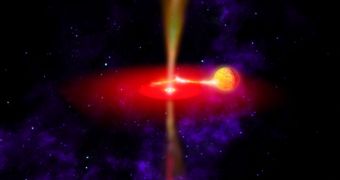A collaboration of astronomers from the University of Utah and the Harvard-Smithsonian Center for Astrophysics (CfA) found in a new study that supermassive black holes can grow by disrupting the gravitational interactions between two stars in a binary system, and then consuming one of them.
Over the years, experts have proposed a number of explanations for how these dark behemoths grow to their impressive sizes and masses. Such objects can tip the scale at anywhere between a few million to a few billion solar masses.
One possible explanation is that supermassive black holes are born large to begin with. Another is that they grow to their hefty sizes by accreting hydrogen gas from their immediate surroundings, or other forms of matter from their accretion disks.
What the new investigation demonstrates is that it is possible for these cosmic structures to grow even further by consuming stars. Their preferred meal, the group explains, appears to be binary systems, which feature two stars orbiting each other, or a common center of gravity.
When such a system moves too close to a black hole, extreme gravitational and tidal effects from the dark behemoth rip the two stars apart, throwing one away from the galactic core, and forcing the other into the black hole.
“Black holes are very efficient eating machines. They can double their mass in less than a billion years. That may seem long by human standards, but over the history of the Galaxy it's pretty fast,” explains CfA investigator Scott Kenyon.
“I believe this has got to be the dominant method for growing supermassive black holes,” concurs astronomer Benjamin Bromley, an expert at the University of Utah. He was also the lead author of the new paper, which appears in the April 2 online issue of The Astrophysical Journal Letters.
Back in 2005, CfA astronomers of Warren Brown's team found that stars formerly in binary systems were leaving the Milky Way at extreme velocities, and hypothesized that they were being flung out of the galaxy by black holes. This new study is a natural continuation of that research.
“We put the numbers together for observed hypervelocity stars and other evidence, and found that the rate of binary encounters [with our galaxy's supermassive black hole] would mean most of the mass of the galaxy's black hole came from binary stars,” Bromley reveals.
“We estimated these interactions for supermassive black holes in other galaxies and found that they too can grow to billions of solar masses in this way,” the astronomer concludes.

 14 DAY TRIAL //
14 DAY TRIAL //